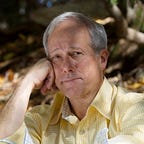ESSAY
Hemingway Among the Modernists: The Birth of Modernism
This is Part 2 (of 5) of my essay, “Hemingway Among the Modernists,” which was originally a lecture I gave at the request of the Hemingway Foundation on July 21, 2012.
Modernism in the opening decades of the 20th century did not have the crisp outlines of the literary movement we see today. Maybe no literary movement does in the throes of its creation. This one was a shifting complex of friendships, mentorships, and rivalries among major writers who were still young and not yet famous. In A Moveable Feast, the posthumous memoir of his Paris years, Hemingway recalled a time of poverty and the nervous anticipation of talents not yet realized, reputations not yet made. Through Ezra Pound and Gertrude Stein, both important mentors, he came to know the other expatriate writers, among them Eliot, Joyce, F. Scott Fitzgerald and Ford Madox Ford. Of all these, it was Pound whose mentorship joined Hemingway and Harriet Monroe, and so made the Poetry magazine connection.
The Hemingways, Ernest and Hadley, lived among the Paris expatriates for most of the 1920s. (A personal footnote: Hadley was Hemingway’s first wife and my favorite among the four he was to have. My wife Penny and I were reading aloud the Carlos Baker biography when she was expecting our first child. I suggested that, if it was a girl, we name her Hadley. Just to show how much weight that carried, our daughter’s name is Jenny.) Hemingway, handsome and a strapping 200 lbs., gave boxing lessons to Pound. He would also finish the fights that Joyce picked with strangers on their pub-crawls. (“Deal with him, Hemingway. Deal with him,” Joyce in his cups would say.) The pugilist in Hemingway was part of what made him so colorful and larger than life. In Key West in 1936, he and Wallace Stevens had a drunken fight in the rain in which Hemingway knocked down Stevens a couple of times, and Stevens broke his hand on Hemingway’s jaw. (Back home in Hartford, Stevens explained that he fell down a flight of stairs.) The following year Hemingway brawled with the writer Max Eastman in the office of their editor, Max Perkins. As a friend of mine would wryly note, at least Hemingway wasn’t competitive. But his love for life made him exuberant in everything — the loving as much as the fighting, which is why Woody Allen and HBO still make movies about him.
Geographical location was one locus that connected these expatriate writers whom Hemingway dubbed “the lost generation” (the phrase originated with Gertrude Stein). Its epicenters were Paris and London and, less recognized but also important, Chicago. In addition to place, the writers shared a locus of attitudes. Although Modernism did not lack for salty admonitions from its colorful apostles on how to write, there never was a tightly codified system of rules or principles such as the French Academy might have recognized. It was more like an eruption of underground energy. The Modernism that swept all of the arts in the opening years of the century was iconoclast, experimental, edgy and impatient with old systems of values and belief. On the subject of civilization and its failures, Pound was trenchant:
There died a myriad,
And of the best, among them,
For an old bitch gone in the teeth,
For a botched civilization.
Charm, smiling at the good mouth,
Quick eyes gone under earth’s lid,
For two gross of broken statues,
For a few thousand battered books.
If one may define any “school” of writing as a group of writers who are joined in their allegiance or opposition to a given thing, but who may agree on little else, that would cover Modernism. One need only compare the poetries of Eliot and Stevens, or Pound and Yeats, or the prose of Joyce and Hemingway, to know that the voices of the Modernists could never be mistaken for one another. Indeed, they differed wildly. As the 1920s and ’30s became the ’40s and ’50s, each of these major writers created an aesthetic domain that was unique unto itself. One way in which these domains differed — and a central theme of my remarks today — lies in how these writers viewed the relationship of their art to external reality, to the world at large.
John Barr’s poems have been published in six books, four fine press editions, and many magazines, including The New York Times, Poetry, and others. John was also the Inaugural President of the Poetry Foundation. His newest book, The Boxer of Quirinal, was published by Red Hen Press and longlisted for the PEN/Voelcker Award for a Poetry Collection in 2024. You can view more of his work on his web site, or Instagram, and sign up for his free newsletter.
